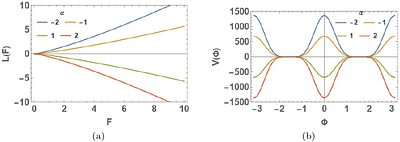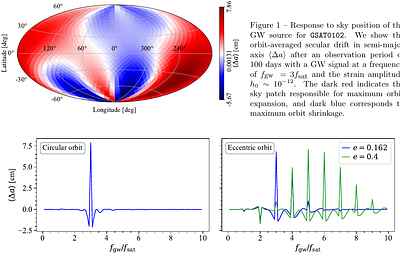By: Uttaran Ghosh, Sarbari Guha
In this paper, we examine the structure scalars formed from the orthogonal splitting of the Riemann tensor of the spacetime metric describing the interior of a charged matter configuration undergoing dissipative collapse in $f(R,T)$ gravity, and how they influence the various physical parameters of the collapsing matter. A treatment is provided for the unspecified $f(R, T)$ function, and the nature of the results for a linear $f(R, T)$ functi... more
In this paper, we examine the structure scalars formed from the orthogonal splitting of the Riemann tensor of the spacetime metric describing the interior of a charged matter configuration undergoing dissipative collapse in $f(R,T)$ gravity, and how they influence the various physical parameters of the collapsing matter. A treatment is provided for the unspecified $f(R, T)$ function, and the nature of the results for a linear $f(R, T)$ function is presented. In the absence of dissipation, the energy density inhomogeneity is influenced by $X_{TF}$ and the mass function. Further, the presence of charge affects the structure scalars and the total mass-energy content. The dependence of various physical parameters, such as heat dissipation, energy density inhomogeneity, evolution of the expansion scalar, the shear scalar, effective homogeneous energy density, and pressure anisotropy, on the structure scalars has been clearly indicated. less
By: B. Sharmila, Sander M. Vermeulen, Animesh Datta
Spacetime fluctuations (SFs), a common feature of different proposed gravity models, could be detected using laser interferometers. In the search for SFs, a correspondence between the expected output signals and different gravity models is needed, both for guiding the design of future interferometers, and for identifying the signal in experimental data. In this work, we provide such a correspondence for some classes of SFs and geometries of t... more
Spacetime fluctuations (SFs), a common feature of different proposed gravity models, could be detected using laser interferometers. In the search for SFs, a correspondence between the expected output signals and different gravity models is needed, both for guiding the design of future interferometers, and for identifying the signal in experimental data. In this work, we provide such a correspondence for some classes of SFs and geometries of the interferometers. We consider three different classes of SFs, characterised by the decay behaviours and symmetries of their two-point correlation functions. Our approach applies to Michelson laser interferometers with Fabry-P\'erot arm cavities such as the km-long LIGO detectors and those without arm cavities such as the laboratory-scale setups QUEST and GQuEST. Analysing the expected interferometer output signals, we identify three characteristic signatures for each class of SF. The designed broadband sensitivity of the laboratory-scale instruments would allow all characteristic signatures of the different classes of SFs to be observed, and such observations could provide more information on the nature of the SFs than those from LIGO. On the other hand, we find that LIGO is better suited for detecting the bare presence or absence of SFs. less
By: Rong-Gen Cai, Li Hu, Shao-Jiang Wang
Recent progress on the black hole information paradox has reproduced the Page curve as required by the unitary evolution of the black hole entanglement entropy. In this Letter, we will argue that, the quantum speed limit on how fast a quantum system can evolve unitarily, when saturating the maximal information transmission bounds (Pendry's bound and Bremermann-Bekenstein bound), will slow down the would-be divergent rate of dynamical black ho... more
Recent progress on the black hole information paradox has reproduced the Page curve as required by the unitary evolution of the black hole entanglement entropy. In this Letter, we will argue that, the quantum speed limit on how fast a quantum system can evolve unitarily, when saturating the maximal information transmission bounds (Pendry's bound and Bremermann-Bekenstein bound), will slow down the would-be divergent rate of dynamical black hole entropy decreasing at the very end of the Hawking evaporation, during which the Penrose inequality from cosmic censorship conjecture is exactly saturated. Therefore, an evaporating Schwarzschild black hole is the fastest transmitter of information in nature. Further applying the Bremermann-Bekenstein bound on the de Sitter entanglement entropy exactly reproduces the trans-Planckian censorship conjecture, indicating that the would-be-ended inflating de Sitter space is the fastest receiver of information in nature. less
By: Adolfo Cisterna, Mokhtar Hassaine, Ulises Hernandez-Vera
We study the thermodynamics of a class of four-dimensional black hole solutions arising from the compactification of a higher-curvature gravity theory featuring an infinite tower of Lovelock-type invariants. For planar horizons, we identify two distinct branches: a regular black hole supported by a nontrivial scalar field and a non-regular general relativity (GR) solution with a trivial scalar profile. Despite their differing geometries, both... more
We study the thermodynamics of a class of four-dimensional black hole solutions arising from the compactification of a higher-curvature gravity theory featuring an infinite tower of Lovelock-type invariants. For planar horizons, we identify two distinct branches: a regular black hole supported by a nontrivial scalar field and a non-regular general relativity (GR) solution with a trivial scalar profile. Despite their differing geometries, both branches share the same free energy at fixed temperature, revealing a thermodynamic degeneracy naturally linked to the enhanced symmetry and scale invariance of the planar base manifold. In the case of a spherical horizon, even if the scalarized branch is not obtained in closed form, one can see that the degeneracy persists in the absence of the quadratic curvature contribution. On the other hand, if this quadratic term is taken into account, the regular solution may be thermodynamically favored (or not) over the Schwarzschild-AdS solution depending on the values of the coupling constants of the theory. less
By: N. V. Krishnendu, Aldo Perri, Sumanta Chakraborty, Alessandro Pesci
Existence of a minimal length in spacetime geometries avoids several singular situations involving quantum theory and gravity. In this work, we show that the existence of such a minimal length also affects the gravitational wave (GW) waveform of any inspiraling binary black hole (BH) system by introducing a minimum frequency, below which the BHs behave as perfectly reflecting compact objects, while above they are identical to classical BHs. T... more
Existence of a minimal length in spacetime geometries avoids several singular situations involving quantum theory and gravity. In this work, we show that the existence of such a minimal length also affects the gravitational wave (GW) waveform of any inspiraling binary black hole (BH) system by introducing a minimum frequency, below which the BHs behave as perfectly reflecting compact objects, while above they are identical to classical BHs. This leads to a significant imprint on the tidal heating term, appearing in the GW waveform at 2.5 post Newtonian order. Based on these modifications to the inspiraling waveform, it turns out that the detection of highly spinning and highly absorbing, almost classical BH like compact objects, inspiraling around each other, would be in tension with the quantum properties of BH geometries. The same would also be true if the zero point length exceeds the Planck length by a significant amount, suggesting that the zero point length, if it exists, must be of the same order as the Planck length, or smaller, purely from GW observations. less
By: Mark P. Hertzberg, Oleksandr S. Stashko
We study static, spherically symmetric neutron stars in a class of scalar-tensor theories with non-canonical kinetic terms (K-essence) obeying all causality and hyperbolicity conditions. These models have non-trivial dynamics that lead to a type of anti-screening of the scalar. They lead to small corrections in the solar system due to a small coupling, but can lead to large corrections in regimes of high densities, especially neutron stars. W... more
We study static, spherically symmetric neutron stars in a class of scalar-tensor theories with non-canonical kinetic terms (K-essence) obeying all causality and hyperbolicity conditions. These models have non-trivial dynamics that lead to a type of anti-screening of the scalar. They lead to small corrections in the solar system due to a small coupling, but can lead to large corrections in regimes of high densities, especially neutron stars. We solve the modified Tolman-Oppenheimer-Volkoff equations numerically using realistic equations of state (SLy4, WFF1, MS1, MPA1). For a given central density, we find that two distinct configurations may exist, forming two separate branches of solutions. We find that above a certain critical central density solutions with the correct asymptotic behavior at spatial infinity cannot be obtained. We obtain precise predictions for the mass-radius relation for neutron stars for different values of the parameters in the model and we compare to data. less
By: Pınar Kirezli, Doğukan Taşer
In this study, the source of the black bounce is discussed in the context of $f(Q)$ theory. A body of research has been dedicated to the study of symmetric black bounce solutions that are generated by a combination of a scalar field with a non-zero potential and a magnetic charge within the framework of non-linear electrodynamics. As exact solutions are not obtained, the metric functions of Simpson-Visser and Bardeen type of black bounce are ... more
In this study, the source of the black bounce is discussed in the context of $f(Q)$ theory. A body of research has been dedicated to the study of symmetric black bounce solutions that are generated by a combination of a scalar field with a non-zero potential and a magnetic charge within the framework of non-linear electrodynamics. As exact solutions are not obtained, the metric functions of Simpson-Visser and Bardeen type of black bounce are studied in the field equations. black bounce solutions are obtained by violating at least one energy condition for the Simpson-Visser and Bardeen type for an ordinary scalar field in $f(Q)$ gravity, which is only achieved by a phantom scalar field in general relativity. less
By: Kristian Gjorgjieski, Jutta Kunz, Petya Nedkova
We study circular orbits and accretion structures around symmetric wormholes. As exemplary solutions we choose three different wormhole spacetimes, namely rotating traversable wormholes from the Teo class, the rotating Simpson-Visser metric with the parameter spectrum corresponding to wormholes and a static wormhole from beyond Horndeski theories. We show the existence of a spectrum of circular orbits at the wormhole throat for each of these ... more
We study circular orbits and accretion structures around symmetric wormholes. As exemplary solutions we choose three different wormhole spacetimes, namely rotating traversable wormholes from the Teo class, the rotating Simpson-Visser metric with the parameter spectrum corresponding to wormholes and a static wormhole from beyond Horndeski theories. We show the existence of a spectrum of circular orbits at the wormhole throat for each of these wormhole solutions and analyze the boundaries of this spectrum across the respective wormhole parameter range. For each of the solutions we identified that vast regions of the parameter space correspond to stable orbits. The presence of this orbit spectrum can be linked through accretion disk models to matter accumulations which may form at the throat. We present here examples of such disk solutions by implementing the Polish Doughnut model. In some cases, these matter accumulations are encapsulating the throat and could imply central bright regions of the wormhole spacetime. Furthermore, the combined analysis of the equatorial Keplerian orbits and the throat orbits, leads to a set of different disk configurations, where matter accumulations at the throat may be present with outer tori around them, in some cases also as a connected structure. Our results may hint to possible instabilities of wormholes, especially if they have an ergoregion. Moreover, wormholes with such disks, may appear more star-like when it comes to their observational signature, due to the centralized and more spherical emission profile associated with the possible matter accumulations at the throat. less
By: Soumen Roy, Bruno Bertrand, Justin Janquart
The detection of gravitational waves opened up a new window to look into the Universe by probing phenomena invisible through electromagnetic observations. As gravitational waves interact very weakly with matter, their detection is challenging and expensive. So far, they have been observed in the nHz frequency and audible ranges. Future detectors are expected to cover the mHz frequency, leaving the $\mu$Hz regime largely unexplored. With on-bo... more
The detection of gravitational waves opened up a new window to look into the Universe by probing phenomena invisible through electromagnetic observations. As gravitational waves interact very weakly with matter, their detection is challenging and expensive. So far, they have been observed in the nHz frequency and audible ranges. Future detectors are expected to cover the mHz frequency, leaving the $\mu$Hz regime largely unexplored. With on-board atomic clocks and orbits determined to the cm, Global Navigation Satellite System constellations (GNSS), like GPS or Galileo, offer free access to more than 30 years of clock and orbit data for tests of general relativity. We develop a framework for calculating the deviation in the evolution of GNSS orbits induced by gravitational wave signals. We show that when a gravitational wave interacts in resonance with a satellite's orbit, effects amplify, which can be used to bridge the gap in the $\mu$Hz regime. Finally, we demonstrate that the orbital deviations induced by gravitational waves are coherent across the entire constellation, enabling a satellite network to disentangle GW effects from satellite systematics. less
By: Jan Novák, Oem Trivedi
We formulate an approach to quantum gravity, called the ring paradigm. Gravity is mediated superluminally, and the graviton is described as a phonon on the grid of matter in the Universe. This theory has very interesting applications to cosmology and would ultimately solve the old problem of the cosmological constant. It further gives new impulses to the scalar field theories because the gravitational ring decays to some phantom field. As is ... more
We formulate an approach to quantum gravity, called the ring paradigm. Gravity is mediated superluminally, and the graviton is described as a phonon on the grid of matter in the Universe. This theory has very interesting applications to cosmology and would ultimately solve the old problem of the cosmological constant. It further gives new impulses to the scalar field theories because the gravitational ring decays to some phantom field. As is obvious, we radically break the Lorentz invariance, which means that some generalization of the Haag-Lopuszanski-Sohnius theorem in quantum field theory is possible. less









